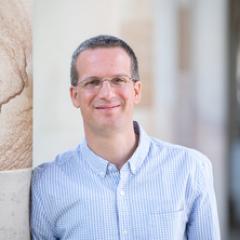I have always been intrigued and fascinated by the importance of the biological time-keeping system in regulating processes as complex and important as learning and memory. We often refer to memories as a defining factor for who we are, similar to a passport or fingerprint "we are our memories". The efficiency by which we acquire new information (learning) and form memories is dependent on temporal factors imposed on those anatomical structures involved in memory processing by our inner time-keeping system. This phenomenon has deep fundamental evolutionary roots since the circadian modulation of learning and memory is conserved across species as we and others have demonstrated.
My research focuses on identifying the biological clocks and pacemakers that regulate hippocampus-dependent learning and memory processes and deciphering the means of communication between the clock and the limbic system (an anatomical structure related to information and emotion processing and storage). Thus, the memories that shape our behaviour are restricted to information we efficiently acquire, which is dependent on the time-of-day when the processing of the information takes place.
If:
- the topic "biological clocks" or circadian biology is on top of your list
- you are a highly motivated individual
- you enjoy working in a team
- you live each day as if it was your last
Then please email me to apply for a PhD position in my lab.
Lucia, D., Burgess, D., Cullen, C. L., Dorey, E. S., Rawashdeh, O. and Moritz, K. M. (2019) Periconceptional maternal alcohol consumption leads to behavioural changes in adult and aged offspring and alters the expression of hippocampal genes associated with learning and memory and regulators of the epigenome. Behavioural Brain Research, 362 249-257. doi:10.1016/j.bbr.2019.01.009
Kim, Pureum, Oster, Henrik, Lehnert, Hendrik, Schmid, Sebastian M, Salamat, Nicole, Barclay, Johanna L, Maronde, Erik, Inder, Warrick and Rawashdeh, Oliver (2019) Coupling the circadian clock to homeostasis: the role of Period in timing physiology. Endocrine Reviews, 40 1: 66-95. doi:10.1210/er.2018-00049
Himmelhan, D. K., Rawashdeh, O. and Oelschläger, H. H. A. (2018) Early postnatal development of the visual cortex in mice with retinal degeneration. Mechanisms of Development, 151 1-9. doi:10.1016/j.mod.2018.03.002
Rawashdeh, Oliver, Parsons, Rex and Maronde, Erik (2018) Clocking in time to gate memory processes: the circadian clock is part of the ins and outs of memory. Neural Plasticity, 2018 6238989-11. doi:10.1155/2018/6238989
Rawashdeh, Oliver, Clough, Shannon J. , Hudson, Randall L. and Dubocovich, Margarita L. (2017) Learned motivation drives circadian physiology in the absence of the master circadian clock. FASEB Journal, 31 1: 388-399. doi:10.1096/fj.201600926R
Rami, Abdalhaq, Fekadu, Julia and Rawashdeh, Oliver (2017) The hippocampal autophagic machinery is depressed in the absence of the circadian clock protein PER1 that may lead to vulnerability during cerebral ischemia. Current Neurovascular Research, 14 3: 207-214. doi:10.2174/1567202614666170619083239
Rawashdeh, Oliver, Jilg, Antje, Maronde, Erik, Fahrenkrug, Jan and Stehle, Joerg H. (2016) Period1 gates the circadian modulation of memory-relevant signaling in mouse hippocampus by regulating the nuclear shuttling of the CREB kinase pP90RSK. Journal of Neurochemistry, 138 5: 731-745. doi:10.1111/jnc.13689
Stehle, Jorg H. and Rawashdeh, Oliver (2016) Ribosomal RNA - A tail wagging the dog?. Journal of Neurochemistry,136 4: 673-676. doi:10.1111/jnc.13499
Rawashdeh, Oliver, Jilg, Antje, Jedlicka, Peter, Slawska, Jolanta, Thomas, Lukas, Saade, Anastasia, Schwarzacher, Stephan W. and Stehle, Joerg H. (2014) PERIOD1 coordinates hippocampal rhythms and memory processing with daytime. Hippocampus, 24 6: 712-723. doi:10.1002/hipo.22262
Rawashdeh, Oliver and Dubocovich, Margarita L. (2014) Long-term effects of maternal separation on the responsiveness of the circadian system to melatonin in the diurnal nonhuman primate (Macaca mulatta). Journal of Pineal Research, 56 3: 254-263. doi:10.1111/jpi.12118
Rawashdeh, Oliver and Maronde, Erik (2012) The hormonal Zeitgeber melatonin: role as a circadian modulator in memory processing. Frontiers in Molecular Neuroscience, 5 FEBRUARY 2012: 1-6. doi:10.3389/fnmol.2012.00027
Stehle, Joerg H., Saade, Anastasia, Rawashdeh, Oliver, Ackermann, Katrin, Jilg, Antje, Sebesteny, Tamas and Maronde, Erik (2011) A survey of molecular details in the human pineal gland in the light of phylogeny, structure, function and chronobiological diseases. Journal of Pineal Research, 51 1: 17-43. doi:10.1111/j.1600-079X.2011.00856.x
Rawashdeh, Oliver, Hudson, Randall L., Stepien, Iwona and Dubocovich, Margarita L. (2011) Circadian periods of sensitivity for ramelteon on the onset of running-wheel activity and the peak of suprachiasmatic nucleus neuronal firing rhythms in C3HHeN mice. Chronobiology International, 28 1: 31-38. doi:10.3109/07420528.2010.532894
Rawashdeh, Oliver and Stehle, Joerg H. (2010) Ageing or NOT, clock genes are important for memory processes: an interesting hypothesis raising many questions. Aging, 2 5: 259-260. doi:10.18632/aging.100148
Gerstner, Jason R., Lyons, Lisa C., Wright, Kenneth P., Jr., Loh, Dawn H., Rawashdeh, Oliver, Eckel-Mahan, Kristin L. and Roman, Gregg W. (2009) Cycling behavior and memory formation. The Journal of Neuroscience, 29 41: 12824-12830. doi:10.1523/JNEUROSCI.3353-09.2009
Rawashdeh, Oliver, de Borsetti, Nancy Hernandez, Roman, Gregg and Cahill, Gregory M. (2007) Melatonin suppresses nighttime memory formation in zebrafish. Science, 318 5853: 1144-1146. doi:10.1126/science.1148564
Lyons, Lisa C., Rawashdeh, Oliver and Eskin, Arnold (2006) Non-ocular circadian oscillators and photoreceptors modulate long term memory formation in Aplysia. Journal of Biological Rhythms, 21 4: 245-255. doi:10.1177/0748730406289890
Lyon, Lisa C., Rawashdeh, Oliver, Katzoff, Ayelet, Susswein, Abraham J. and Eskin, Arnold (2005) Circadian modulation of complex learning in diurnal and nocturnal Aplysia. Proceedings of the National Academy of Sciences of the United States of America, 102 35: 12589-12594. doi:10.1073/pnas.0503847102

